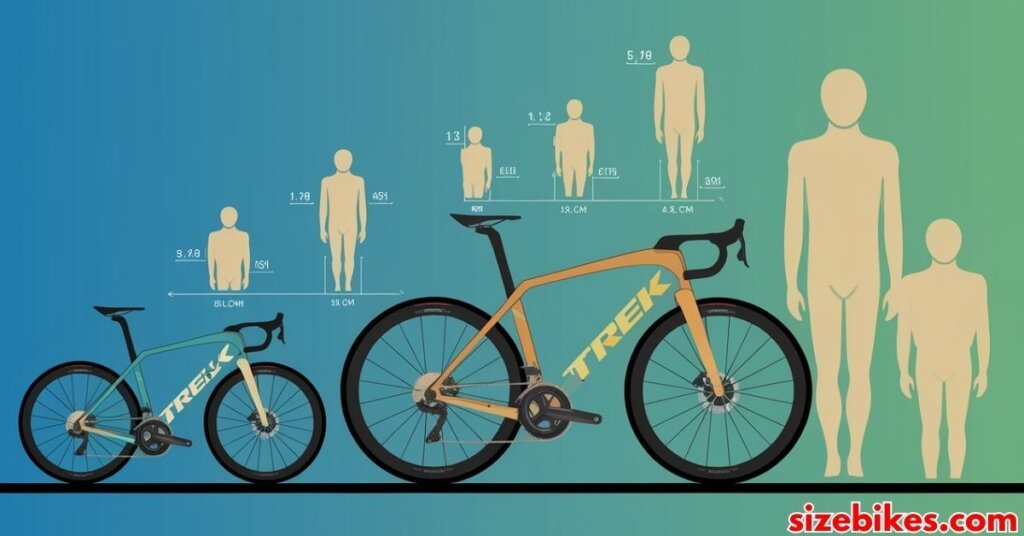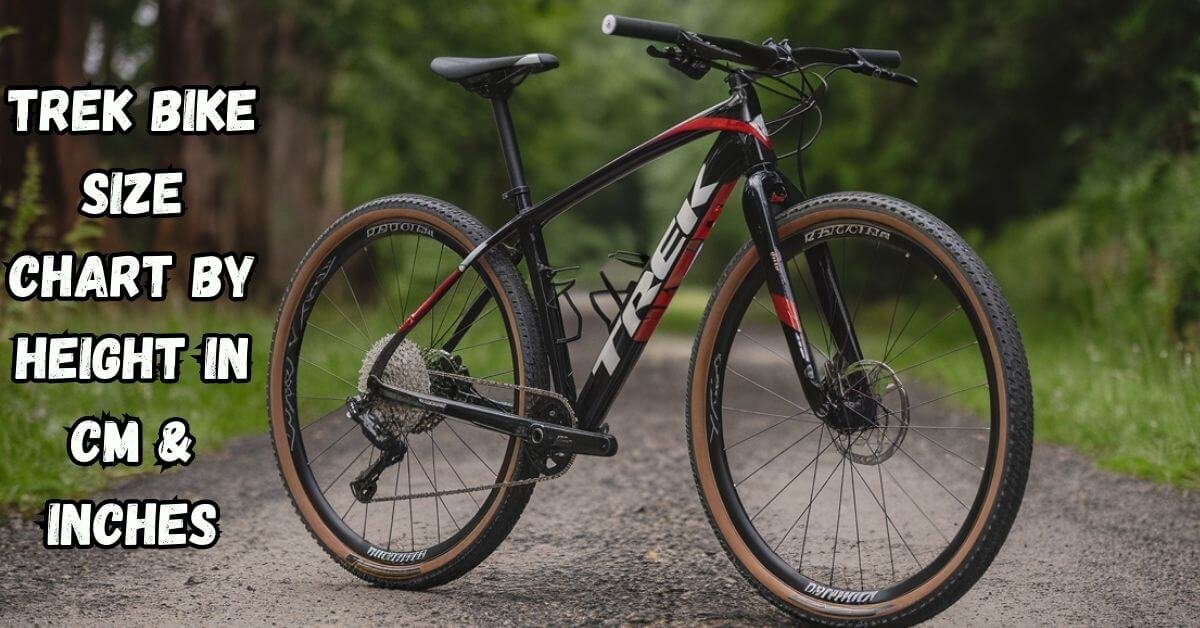The Trek Bike Size Chart by height in cm and inches helps riders find the right bike frame size. This now guarantees riding comfort and efficiency according to one’s height.
More so, it is important to select the right bike size to enhance the riding experience. The Trek Bike Size Chart gives the ability to read cm and inches for simple understanding. With the right fit, you can ride easily and with confidence. Alright, let’s check the chart to see which Trek bike size fits you best.
The Trek Bike Size Chart indicates the approximate rider height in centimeters and inches for every frame size offered. It helps ensure a proper fit for maximum comfort and performance. Sizes typically range from small to extra-large. Always refer to the chart before purchasing a Trek bike to find your ideal size.
Table of Contents
Bike Sizing Guide

Why bike size matters
Comfort: Provided the bicycle has the correct dimensions, it is possible to ride without experiencing any back, neck, or limb strain. However, riding bicycles that are either oversized or undersized can cause discomfort, leading to a reduced riding period.
Control: Proper sizing of the bike helps improve handling. It is easier to control the bike when it fits properly, reducing the chances of the rider getting injured on ego-friendly adventures in different kinds of terrain.
Performance: The size of the bike—it’s geometry—makes a direct contribution to sustainable and overall cycling performance. A properly adjusted bicycle is conducive to effective pedaling, enhanced energy transfer, and speed improvement.
Factors Influencing Bike Size
Height: Your height is the most straightforward factor in determining bike size. It directly correlates to frame size.
Inseam Length: The inseam height, defined as the distance from the top of the inner thigh to the floor, is a very important dimension in fitting a bicycle. This measurement is necessary in ensuring that the rider can access the pedals comfortably as well as the ground when need be.
Riding Style: The riding pattern and purpose of use may also determine the size that one selects. For instance, road bike users are likely to opt for a more bent forward position, while mountain bike users are likely to stay sitting more upright.
Body Proportions: Not everyone with the same height has the same body proportions. Some might have longer legs relative to their torso, which can influence frame size preference.
Trek Bike Size Chart

In order to facilitate your decision-making process and enhance your overall experience, we have put together an insightful Trek bike size guide for road bikes and mountain bikes issued by the company. The chart presents recommendations for height in centimeters (CM) and inches. It also gives the corresponding frame sizes.
Trek Bike Size Chart for Road Bikes
Size | Height (CM) | Height (Inches) | Frame Size (CM) | Frame Size (Inches) |
XS | 150 – 162 | 4’11” – 5’4” | 47 – 50 | 18.5 – 19.5 |
S | 162 – 170 | 5’4” – 5’7” | 50 – 52 | 19.5 – 20.5 |
M | 170 – 178 | 5’7” – 5’10” | 54 | 21 |
L | 178 – 186 | 5’10” – 6’1” | 56 – 58 | 22 – 23 |
XL | 186 – 194 | 6’1” – 6’4” | 58 – 61 | 23 – 24 |
Size | Height (CM) | Height (Inches) | Frame Size (CM) | Frame Size (Inches) |
XS | 150 – 162 | 4’11” – 5’4” | 13 – 14 | 13 – 14 |
S | 162 – 170 | 5’4” – 5’7” | 14 – 16 | 14 – 16 |
M | 170 – 178 | 5’7” – 5’10” | 16 – 18 | 16 – 18 |
L | 178 – 186 | 5’10” – 6’1” | 18 – 20 | 18 – 20 |
XL | 186 – 194 | 6’1” – 6’4” | 20 – 22 | 20 – 22 |
Detailed Analysis of Frame Sizes
What Does Frame Size Mean?
When the frame size is referred to in a bike, it is basically the measurement of the seat tube, which is the tube extending from the bottom bracket, not the pedals attached to it, but the position where the tube angles are joined with the top of the seat tube. The frame sizes are often measured in centimeters (CM) and inches. It is essential to choose the right frame size, as it will affect the rider’s position and comfort level.
XS (Extra Small): Most appropriate for shorter riders, these bikes have smaller frame sizes and are suited to the first cycling experience or to the more easy-going riding style.
S (small): This size is intended for users of average height and allows for both efficient and comfortable utilization. Smaller frames quite often have more upright geometry.
M (medium): Medium-size frames are created for a huge general of riders. They are commonly used by leisure cyclists who wish to enjoy comfort and efficiency at the same time.
L (large): Large frames are designed for taller riders who require a more extended reach. These bikes often have a more aggressive geometry, suitable for road racing.
XL (Extra Large): Extra large frames provide the highest reach and are tailored for very tall riders. They allow for aggressive riding positions and advanced performance features.
Stand-Over Height
Stand-over height With regards to the cyclist’s perspective, it is the height, which is measured from the ground to the top tube of the bicycle frame. This is a crucial aspect of bike fittings, especially cold-weather bicycles.
For road bikes: A 1-2 inch clearance is enough. It enables one to get on and off the cycle comfortably without touching the top tube.
For mountain bikes, this should be at 3-4 inches, which is better for a rider to get off considering that the rider will have to face rough surfaces.
Seat Height Adjustment
An important feature is the height adjustment of the seat, as it permits effective leg extension while pedaling. In bicycle terms, the rider’s leg when the pedal is in the lowest position should be fully stretched. A leg slightly bent is therefore expected to cause the heel to hit the pedal at the bottom position.
Tips for Choosing the Right Trek Bike Size
Could you specify the topic or keyword you’d like me to include in the sentence?
1. Measure Your Height and Inseam
To select the appropriate bike size, start by measuring your height. Position yourself perpendicular to the wall without wearing any footwear, and take a measuring tape to record your height in cm and inches.
Inseam measurement is equally important. To measure your inseam:
Sylvian fissure separating two hemispheres caudal to measurement.
Position one of the thighs straightened and the other bent in a relaxed position so as to prevent pressing down on the object.
Measure from the top of the book to the floor.
2. Consult the size chart.
Using the measurements from the height and inseam, consult the Trek bike size chart provided earlier. This helps you determine your ideal frame size.
3. Test Ride the Bike
If possible, test ride several bikes in different sizes. Pay attention to how the bike feels. Here are some factors to consider during the test ride:
Comfort: Do you feel comfortable while seated and standing?
Reach: Can you comfortably reach the handlebars without straining?
Control: Does the bike feel stable and simple to maneuver?
4. Consider Your Riding Style
The style of riding can also affect the choice of bicycle size. This is common when, for instance, road racing is anticipated, in which case you would probably want a bike that is relatively smaller than usual for better aerodynamics. On the other hand, if leisurely rides are favored, a bigger bike would be considered more comfortable.
5. Factor in Future Growth
Future needs are an issue of focus when one is shopping for a kid, or rather any other rider who is young. In such instances, a bike that caters for some extent of growth would be ideal. For instance, a bike with adjustable seat height and even handle bars would be suitable since the bike would be used for a longer time.
6. Consult a Professional
You should visit the nearest bicycle shop if you have questions about sizing or fitting. Such services can be provided by trained personnel who work at the shop.
Conclusion
Trek bike size selection plays an important role in achieving a cycling experience that is safe, comfortable, and enjoyable. It is therefore important to use the Trek bike size chart, appreciate why one’s inseam is important, and take other measurements, such as stand-over height and riding style, that will ensure one gets the appropriate bike for his or her cycling purpose.
A properly used bike prescription will lead to better performance, control, and comfort, allowing one to go for longer rides without any weariness or strain. Cycling is not only about moving from A to B; it involves the process, the adventure, and the beauty of riding a bicycle.
With the proper Trek bike, you need to take full advantage every single time you ride the bike; you can go riding in new places and appreciate nature. Enjoy Cycling!

